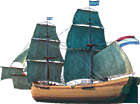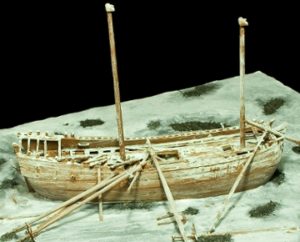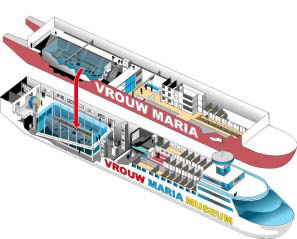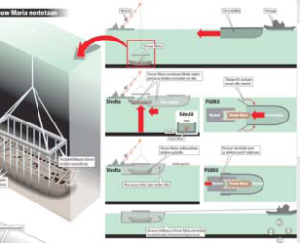Northern Hemisphere: The Vrouw Maria Ship sunk in 1771
The Dutch vessel Vrouw Maria is since 1771 standing on the sea floor southwest of Finland, wrecked on a journey from Amsterdam to St Petersburg.

It is believed that the cargo includes a large number of paintings and other art objects that Catherine the Great of Russia acquired at an auction in Amsterdam after the death of the famous Dutch art collector Gerrit Braamcamp. The vessel and her cargo represent a uniquely European cultural heritage.

In 1999, the experienced diver Rauno Koivusaari and his team managed to locate the wreck using side-scan sonar. Vrouw Maria is located at a depth of only 41 meters and appears to be in very good condition, even if the salvage operations of the time damaged the ship to some extent. She is approximately 26 meters long, 7 meters wide and lies on her keel on the bottom of the sea leaning slightly to her starboard side. The masts, which are standing up, rise to a depth of 22-24 meters. (Wooden model created by Kalle Salonen.)
Between 2001 and 2004, Vrouw Maria was part of a European project called MoSS (Monitoring, Safeguarding and Visualizing North-European Shipwreck Sites), the first international shipwreck project within the European Community Culture 2000 programme.

The KE Group has established a venture with the aim of salvaging the ship and placing her in a floating mobile museum, in cooperation with other countries having an interest in the Vrouw Maria. The museum will also include an international conference centre focussing on cooperation for the sustainable future of the Baltic Sea and the surrounding countries.

The underlying reasoning behind the KE Group concept is that documentation, conservation and salvaging piece by piece would require an enormous number of diving hours. In addition, the ship is so fully loaded that there is not enough space for divers to penetrate it safely. The entire ship, along with the cargo, will therefore be lifted all at once into a special container having perfectly controlled conditions.
(Graphics: Osmo Päivinen)
Hence the ship and all artefacts stay in the same surrounding water at all times, and documentation and conservation work can be performed aboard the Museum vessel from day one and onwards. This allows the public to take part in the process, at close range and in a unique manner, while the concept also helps to continuously finance the preservation, documentation and knowledge sharing of this important cultural heritage.
